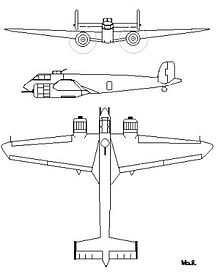Savoia-Marchetti SM.89
| Savoia-Marchetti SM.89 | |
|---|---|

|
|
| Type: | bomber |
| Design country: | |
| Manufacturer: | |
| First flight: |
July 28, 1942 |
| Number of pieces: |
1 prototype |
The Savoia-Marchetti SM.89 was a twin-engine bomber made by the Italian manufacturer Savoia-Marchetti in the 1940s, but which did not get beyond the prototype stage. Since the Italian Air Force needed a fast twin-engined bomber like the Junkers Ju 88 and the German Junkers factories could not provide high enough numbers, it was decided to build their own machine in Italy for this task. After completing the prototype, it was found that it did not meet the required requirements, after which the project was discontinued.
history
Since the Regia Aeronautica in 1940 needed 350 Junkers Ju 88s, but these could not be delivered from Germany, it was decided to commission their own machine of this bomber type. The Savoia-Marchetti company was commissioned to develop such an aircraft. The designer Alessandro Marchetti presented the concept on April 13, 1941, which was accepted by the Regia Aeronautica. This ordered a prototype of the Savoia Marchetti SM.89, which was completed on July 28, 1942.
Alessandro Marchetti's concept was based on a twin-engine version of the SM.84 , a medium-sized three-engine bomber that was already in service. The cabin was changed so that the pilot, radio operator and gunner sat behind one another. To protect the crew, armor weighing 300 kg was installed, which of course reduced the payload. The bow with dural sheets and the tubular steel frame were taken over from the SM.84 and modified so that it could accommodate the heavier armament. The rear fuselage, like the double tail unit, was clad with plywood, some of which was covered with linen. The wings of the low- wing aircraft were a three-spar, pure wood construction, which was clad with plywood. This was later replaced by steel pipes that were clad with aluminum sheets. The retractable tail wheel landing gear was operated hydraulically and moved into the engine nacelles.
drive
The plan was to use the Piaggio P.XI 14-cylinder twin- star engines (Italian licensed construction of the Gnome Rhone Mistral Major 14K with 1000 hp take-off power), but these proved to be too weak, so that one could rely on the more unreliable but more powerful air-cooled 18 Cylinder double radial engines Piaggio P.XII had to change. It was not possible to switch to Piaggio P.XV engines (1650 hp starting power). Adjustable three-blade metal propellers were supposed to provide propulsion.
Armament
The armament was two 37-mm automatic cannons Breda 45 with 40 rounds each and three 12.7-mm machine guns SAFAT with 1000 rounds each. It was still planned to mount two 12.7 mm SAFAT machine guns, each with 1000 rounds, in the turret on the back of the fuselage, but that did not happen. The SM.89 could carry 1,000 to 1,350 kg of bombs, depending on the operational range.
Test phase
On July 28, 1942, the prototype took off on its maiden flight in Vergiate under test pilot Guglielmo Algarotti. The tests were successful, so that in October 1942 the bomber was transferred to Guidonia near Rome for military flight tests . During the military tests it was found that the SM.89 was difficult to fly and land, the low speed made the bomber sluggish and sluggish. The suggestion to install Piaggio P.XV engines (1650 HP take-off power) was rejected because they were heavier and therefore more of the payload would have to be given up, apart from the fact that they could not be procured in sufficient numbers.
testing
For the purpose of troop testing, the machine then came to Cerveteri for the 173rd Squadron, where it was used in ground combat missions and proved itself well. Nevertheless, the SM.89 was left behind at Cerveteri airport on July 10, 1943 when the 173rd squadron was relocated, as the project had already been discontinued in April 1943. The SM.89 was damaged in an air raid by the US Air Force and destroyed by the German Wehrmacht before it retreated.
Technical specifications
| Parameter | Data |
|---|---|
| crew | 4th |
| length | 18.20 m |
| span | 21.60 m |
| height | 4.60 m |
| Wing area | 62.40 m² |
| Wing extension | 7.5 |
| Propeller surface | 10.18 m² |
| Empty mass | 8800 kg |
| drive | 2 × Piaggio P.XII RC35 with 1,500 PS (1,103 kW) |
| Takeoff mass | 12,640 kg |
| Max. Takeoff mass | 14,020 kg |
| Top speed | 465 km / h at an altitude of 4000 m |
| Cruising speed | 378 km / h at an altitude of 3000 m |
| Service ceiling | 8200 m |
| Climb performance | 5.7 m / s |
| Range (max.) | 780 km (1650 km) |
| Armament | two 37 mm Breda 45 automatic cannons, three 12.7 mm SAFAT machine guns, bombs up to 1,350 kg |
literature
- Walter J. Boyne: Clash of Wings: World War II in the Air. Simon & Schuster, New York 1994, ISBN 0-671-79370-5 .
- Giorgio Dorati: Gruppo Modellistico Sestese. Savoia Marchetti SM.89
